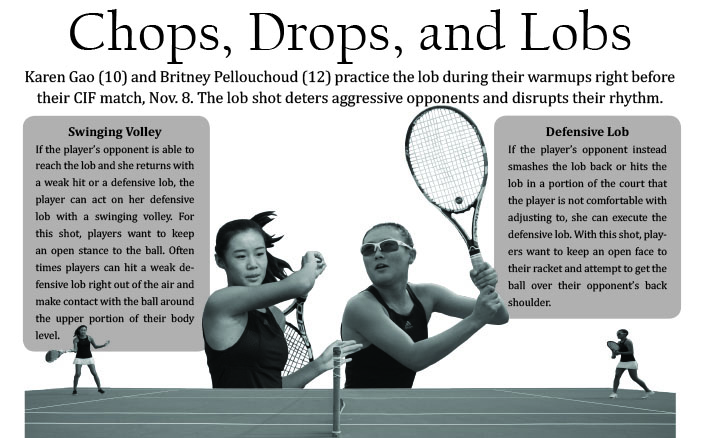
Jane Wang (10) and Karen Gao (10) dominated the court, winning both of their CIF doubles matches against East Lake High School, 6-3 and 6-0 and the Academy of Our Lady of Peace, 6-2 and 6-1. Nov. 8. One of the most vital components to her success was her use of the lob. In tennis, the lob is a type of shot that takes the ball high and deep into the opponent’s court.
“I [hit lobs] because my opponents’ shots and rhythms are often too fast and mine isn’t fast enough,” Wang said. “I hit lob shots basically to disrupt their rhythm.”
A perfectly executed lob will make use of the space behind aggressive opponents who come to the net. However, situations aren’t always ideal, especially when players are under pressure, and poorly-timed lobs can be smashed back past the player.
Before hitting a lob, it is essential that the opponent is near the net as the ball must be hit over them.
If the opponent is already aggressive, she will naturally move closer to the net.
But if she tends to stay towards the back of the court, a player can lure her forward, using several techniques. Short, defensive ground strokes, dinks, and drop shots can pull the opponent out of her comfort zone and closer to the net. Once this is accomplished, the player can prepare to hit a lob.
For grip, a forehand grip used for ground strokes or a regular backhand grip is ideal.
In terms of stance, a player should maintain an open stance so that she can rotate more easily and create the heavy topspin needed to lift the ball over the opponent’s head and into the court beyond her reach.
“In tennis, grip, stance and swing are so essential,” Wang said. “Attention to detail is a necessity if you want to be successful.”
Players can execute the lob through multiple ways, but all of them begin with a swing path below the ball that ends high to create loft and distance with the ball.
For the forehand bunt lob, the racket is brought upwards to the ball with an open face. The player should be moving forward and pushing off her back leg to meet the ball in front. This forehand bunt lob is the most basic type of lob.
Like the forehand bunt lob, the backhand slice lob requires the player to move her body forward, push off her back leg, and keep her racket open faced. However, this swing should make contact with the ball slightly behind the forehand bunt lob.
The purpose of the topspin lob is to create lots of topspin—a fast forward spinning motion imparted to a ball when hitting it. In order to do this, a player must lift the racket using the power of her legs and drop the racket slightly below the ball right before contact.
Players can even wait for the ball to get close to them before hitting it to get the optimal amount of lift, leverage and topspin. When the ball hits the opponent’s side of the court, the topspin generated from this swing will cause the ball to bounce away from the opponent very quickly, so that she can’t reach it.
“Topspin is really great sometimes,” Wang said. “If your placement of the ball wasn’t the greatest or your opponent is just really quick, that extra bit of spin can be enough to win you a point.”
But situations aren’t always perfect, especially when players are under pressure and are playing at higher levels of competition. Thus, it is important for players to be alert and ready to react immediately after executing the lob.
When a player’s opponent reaches a lob, the aftermath can be quite devastating, as she can often smash the slow-moving lob with incredible speed. However, there are two main methods to counter this weakness: the swinging volley and the defensive lob (above).



